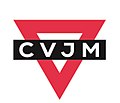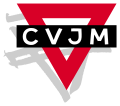YMCA General Association in Germany
| YMCA General Association in Germany | |
|---|---|

|
|
| legal form | registered association |
| founding | 1882 |
| people | Steffen Waldminghaus (President), Hansjörg Kopp (General Secretary), Rainer Heid (Managing Director) |
| sales | 14,202,828 euros (2017) |
| Employees | 135 (2017) |
| Volunteers | 200 (2017) |
| Website | cvjm.de |
The CVJM Germany (CVJM-Gesamtverband in Deutschland eV) is an association based in Kassel . It is the umbrella organization of thirteen federally independent Christian youth associations in Germany, which appear under the following names: Christian Association of Young People , Evangelical Youth Organization (ejw) and Christian Youth Village Organization of Germany (CJD). It is the largest ecumenical Christian youth organization in Germany with a largely Protestant majority and character. The focus of the member associations is local youth work in the 1,400 clubs, youth organizations and youth villages.
organization
structure
It is chaired by the general assembly , the main committee and the board of directors. Pastor Hansjörg Kopp has been the general secretary of the general association since 2017 .
Facilities
In Kassel, the YMCA maintains two training centers for YMCA secretaries and youth officers, the YMCA college and the YMCA college .
Memberships in other associations
National Associations
The YMCA Association is a member of the Working Group of Evangelical Youth in Germany. V. (aej) and the Missionary Services Working Group of the Evangelical Church in Germany . It is the union of 13 independent member associations, whose cooperation it promotes.
In addition, the YMCA is a member of the bka e. Along with 35 other national associations . V. , the Federal Association for Cultural Work in Protestant Youth. V. The associations ensure the diversity and quality of youth cultural work in the Bundesverband Kulturarbeit in der Evangelischen Jugend e. V. and can not least thanks to the association in the bka e. V. take effect nationwide.
YMCA World Federation
The ecumenical Christian associations of young people are united in the YMCA World Alliance ("World Alliance of YMCAs") and have 45 million members in 120 countries worldwide.
DZI donation seal
In July 2010 the YMCA Association received the DZI donation seal . In addition, the association bears the donation test certificate from the German Evangelical Alliance.
Symbols
YMCA triangle
The symbol used by the YMCA Association is a slight modification of the international YMCA symbol: a red, equilateral triangle with a horizontal black bar on which the respective abbreviation is written in white capital letters, in Germany "YMCA". It is a reminder that the whole person is in the foreground in all of the YMCA work. The upper bar stands for "spirit", supported by the two bars for "body" and "soul". It was designed by Luther Gulick in the late 19th century and was first officially used by the YMCA in Springfield in 1890/91 . The symbol quickly developed into the unofficial identification mark of the YMCA, other designs met with rejection and were discarded. Gulick's triangle became the official symbol of the English YMCA during the First World War , and later also the YMCA World Federation. In Germany it did not gain acceptance until after the Second World War .
Young crew work
The “anchor cross” is used in the young crew work. The white color stands for purity, truth and clarity and the blue for God's faithfulness. The cross and the anchor stand for the secure hold that Christians have with Jesus. (cf. Hebrews 6:19). The rings symbolize the worldwide fellowship with other young groups, the worldwide YMCA, as well as the Christian community in general.
Sports work
Furthermore, there is the "oak cross", which was used in all YMCA sports work until 2006 and has only been used by a few regional associations since then. The oak cross was developed by Johannes Tack in 1921 for all of the work in the National Association of Young Evangelical Men. The green leaves of the oak are often understood in Germany as a symbol of steadfastness, victory and new life, which is consciously associated with Jesus Christ or Christianity through the cross-shaped arrangement .
history
founding
In Germany, in 1848, several Protestant youth associations merged to form the first regional association, the Rhenish-Westphalian Youth Association under Superintendent Karl Emil Krummacher as President, a forerunner of the YMCA West Association. In the years that followed, further regional associations of youth associations with different work focuses emerged, which from 1882 worked together in the form of a conference. Approximately simultaneously with the formation of this conference was in 1883 in Berlin at the suggestion of Friedrich von Schlümbachs , a US-trained preacher, the first association dedicated to the Christian Association of young men called, whose first chairman was Eberhard von Rothkirch and Andreas Graf von Bernstorff was his deputy; he joined the Eastern Youth Union . In contrast to the youth associations, which arose as an association of already believing youth and men, the main goal of the YMCA was the evangelism of men who were distant from the church. Conflicts between the two related movements also arose from the fact that the YMCA / YMCA was non-denominationally oriented, while the youth unions were oriented towards the regional church.
Development until 1934
When the regional youth unions merged in 1900 to form the national union of evangelical youth unions, the regional church orientation had prevailed: In § 4 of the statutes it was stipulated that the member associations “stand on the ground of their evangelical regional churches and cannot form alliances outside the regional churches The new national federation continued to be characterized by strong differences in work, which were deepened by the addition of new forms of work. Working groups were set up for the individual branches of work, some of which were later converted into independent associations outside the National Association or the Reich Association. In 1919 the missionary-oriented YMCA groups joined together in a working group, which shaped the 1921 Reich Association of Evangelical Young Men and related efforts (in short: Young Men Work ) more and more. In 1921 the evangelical scouts also joined together in the form of a working group, the Christian Scouting Association of Germany , which became an independent association in 1931/33. From 1922 - starting from the Westbund - sporting work in the general association spread under the name Eichenkreuz . Until 1933/34, the young men’s work was increasingly shaped by the YMCA work, other branches of work left the association or only remain loosely connected to it as a “related endeavor”.
The YMCA during National Socialism
The incorporation of the Protestant youth associations into the Hitler Youth at the beginning of 1934 marked a major turning point in the work of the Jungmännerwerk. Like almost all other Protestant youth associations, it dismissed all members under the age of 18 from membership in order to avoid compulsory membership in the Hitler Youth. The clubs were replaced by community youth groups without defined membership. In the church struggle between German Christians and the Confessing Church , the young men’s work did not position itself uniformly. The Westbund, headed by Johannes Busch , clearly declared itself in favor of the Confessing Church, while other regional associations remained neutral or tended towards the German Christians. During the period of National Socialism , the work of the Jungmännerwerk was subject to ever increasing restrictions until it largely came to a standstill with the outbreak of World War II . During the war, numerous German soldiers who had become prisoners of war came into contact with the YMCA World Association through the prisoner-of-war service.
YMCA after 1945
Work on rebuilding the Jungmannwerk began shortly after the end of the war. The local groups were often among the first youth groups allowed by the occupation authorities. Soon the work was carried out under the name YMCA; the renaming and restructuring to today's Christian Association of Young People continued until the 1970s, when girls were officially allowed to become members.
In 1955, Indiaca, a hand shuttlecock game, which is a variant of the Peteca games of the indigenous people of Brazil , was introduced to the boys' shank . Since 1968 German championships have been held according to the Indiaca rules of the YMCA Association of Germany.
In 2006, the sports work of the YMCA Association in "YMCA Sport" has renamed and thereby visually from their initial relations with the Germans renounced.
Expo 2000
In 2000, the YMCA participated together with World Vision Germany and the Evangelical Alliance with the Pavilion of Hope project at the Expo 2000 , the theme day was July 31, 2000.
General secretaries of the YMCA Association
- 1964–1973 Pastor Walter Arnold
- 1975–1984 Matthias Dannenmann
- 1984–2005 Pastor Ulrich Parzany , chief publisher of ProChrist
- 2005–2010 Wolfgang Neuser , member of the board
- 2011–2015 Roland Werner
- from 2017 Pastor Hansjörg Kopp

Member associations
- Working group of the YMCA Germany (AG of YMCA)
- Christian Youth Village Association of Germany (CJD)
- CVJM-Landesverband Bayern eV
- CVJM Norddeutschland eV
- CVJM-Ostwerk eV Landesverband Berlin-Brandenburg
- CVJM Pfalz eV
- CVJM Baden eV
- CVJM-Landesverband Sachsen eV
- CVJM-Landesverband Sachsen-Anhalt eV
- CVJM-Landesverband Schlesische Oberlausitz eV
- CVJM Thuringia eV, Protestant youth organization
- YMCA West Confederation
- Evangelical Youth Organization in Württemberg (ejw)
The CVJM-Landesverband Württemberg e. V. This is a member of the EJW and is only thereby connected to the YMCA Association.
literature
- Martti Muukkonen: Ecumenism of the laity, Continuity and Change in the Mission View of the World's Alliance of Young Men's Christian Associations, 1855-1955. (PDF) Dissertation University of Joensuu (Finland), 2002, p. 465 , accessed on May 30, 2019 .
- Bettina Joergens: Masculinity. German Youth Association, YMCA and Naturefriends Youth in Minden, 1945–1955 . Potsdam 2006, ISBN 3-935035-57-8 .
- Karl Kupisch: The German YMCA. From the history of the Christian associations of young men in Germany . Pflugschar-Verlag, Kassel-Wilhelmshöhe 1958.
- Rolf Müller: so that they are all one. The development and work of the Jungmannwerke in the GDR and the YMCA Association from the mid-1970s. Neukirchener Aussaat Verlag, Neukirchen-Vluyn 2011.
- Jürgen Müller-Späth: The beginnings of the YMCA in Rhineland and Westphalia. A contribution to social and church history in the 19th century . Series of publications by the Association for Rhenish Church History, Vol. 90, Rheinland-Verlag, Cologne 1988.
- Ulrich Schwab: Christian Association of Young People (CVJM) . In: Historical Lexicon of Bavaria.
- Walter Stursberg: Believe Dare Act. A history of the YMCA movement in Germany. Aussaat Verlag, Wuppertal 1977, ISBN 3-7615-0259-1 .
See also
Web links
- YMCA General Association in Germany
- Working group of the YMCA Germanys e. V.
- Link catalog on the subject of the YMCA General Association in Germany V. at curlie.org (formerly DMOZ )
- Youth in Germany 1918 to 1945: Christian Association of Young Men (NS Documentation Center of the City of Cologne)
Individual evidence
- ↑ YMCA General Association: Hansjörg Kopp is the new Secretary General , idea.de, message from October 23, 2016.
- ↑ CVJM-Gesamtverband in Deutschland eV DZI , accessed on February 17, 2018 .
- ↑ Maren Kockskämper: YMCA-General Association receives donation test certificate. Christian Association of Young People (YMCA / YMCA), August 25, 2010, archived from the original on August 25, 2010 ; Retrieved August 25, 2010 .
- ↑ Rolf Müller, that they may all be one. The development and work of the Jungmannwerke in the GDR and the YMCA Association from the mid-1970s, Neukirchener Aussaat Verlag: Neukirchen-Vluyn 2011, p. 276f.
- ↑ Whale stranded: Groundbreaking for the “Pavilion of Hope” at the Hanover Expo. BauNetz, June 25, 1999, archived from the original on July 13, 2010 ; Retrieved July 13, 2010 .
- ^ Pavilion of Hope eV (CVJM, World Vision, German Evangelical Alliance). Exposeum eV, archived from the original on June 24, 2004 ; accessed on July 29, 2010 (German).
- ↑ Dr. Roland Werner new general secretary of the German YMCA. YMCA General Association in Germany, July 3, 2010, archived from the original on July 3, 2010 ; Retrieved July 3, 2010 .
- ↑ http://www.ejwue.de/cvjm/






